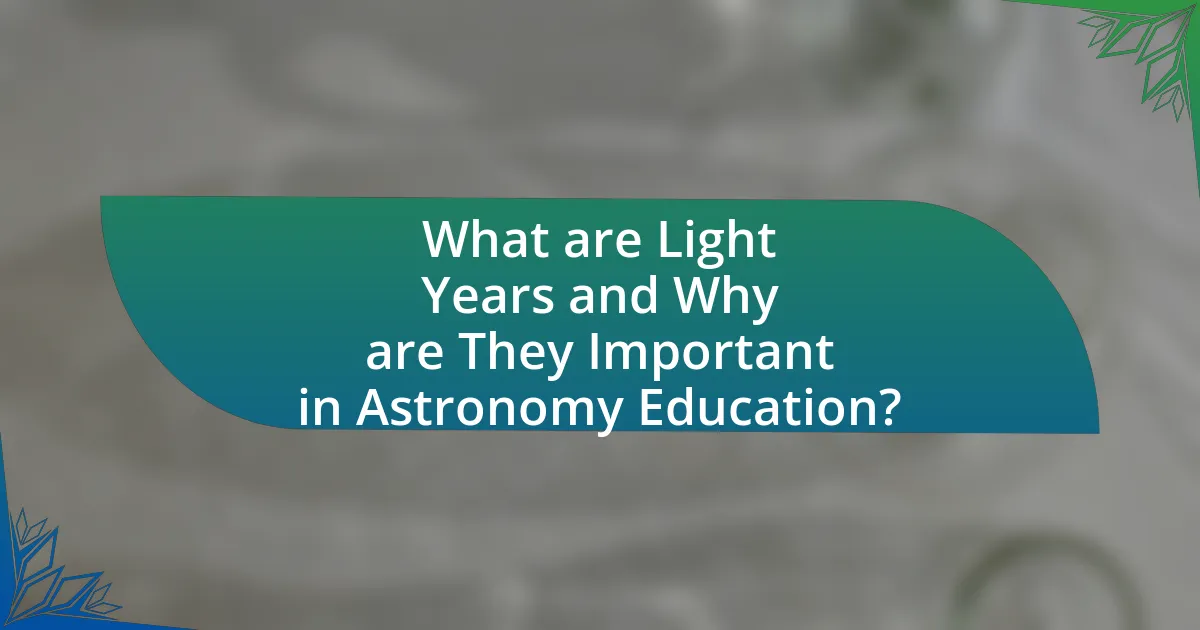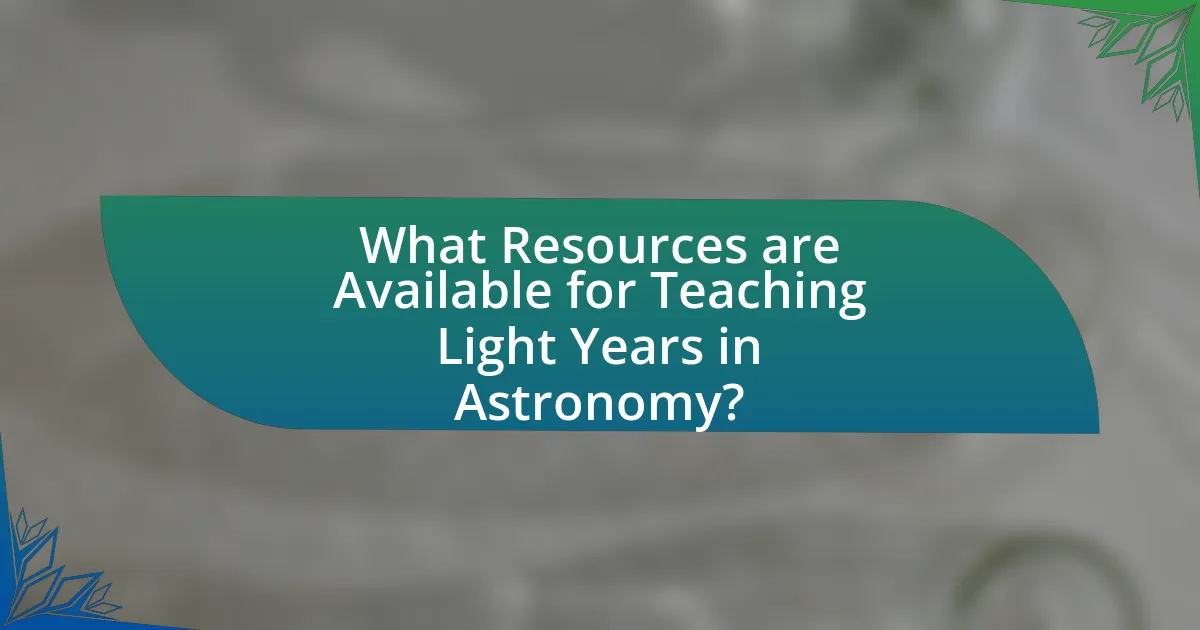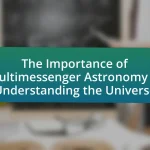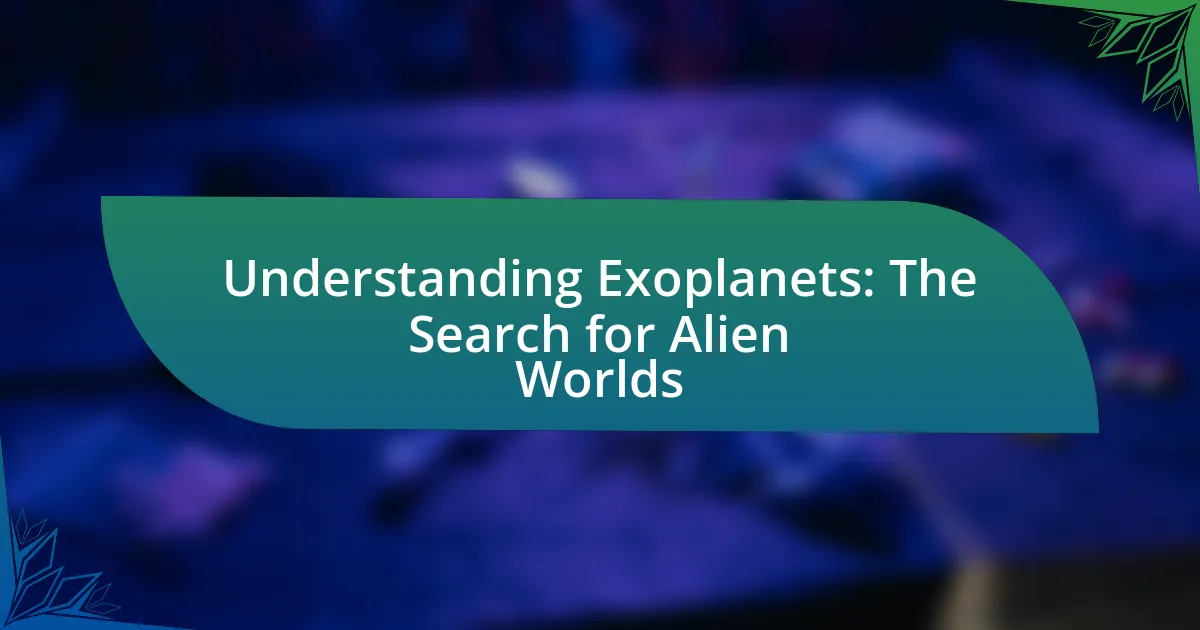Light years are a fundamental unit of distance in astronomy, representing the distance light travels in one year, approximately 5.88 trillion miles or 9.46 trillion kilometers. This measurement is essential for understanding the vast scales of the universe, as it helps students and enthusiasts grasp the distances between celestial objects, such as stars and galaxies. The article explores the definition of light years, their significance in astronomy education, the relationship between distance and light travel time, and effective teaching methods to convey this concept. Additionally, it addresses common misconceptions, challenges faced by students, and resources available for educators to enhance comprehension of light years in the context of astronomical phenomena.

What are Light Years and Why are They Important in Astronomy Education?
Light years are a unit of distance used in astronomy to measure how far light travels in one year, approximately 5.88 trillion miles or 9.46 trillion kilometers. This measurement is crucial in astronomy education because it helps students and enthusiasts comprehend the vast scales of the universe, allowing them to grasp the distances between stars, galaxies, and other celestial objects. For instance, the nearest star system, Alpha Centauri, is about 4.37 light years away, illustrating the immense space between stars. Understanding light years fosters a better appreciation of cosmic phenomena and the structure of the universe, which is essential for anyone studying or interested in astronomy.
How is a Light Year Defined in the Context of Astronomy?
A light year is defined in astronomy as the distance that light travels in a vacuum in one year, approximately 5.88 trillion miles or 9.46 trillion kilometers. This unit of measurement is crucial for expressing astronomical distances, as it allows for a more comprehensible understanding of the vast scales involved in the universe. For instance, the nearest star system, Alpha Centauri, is about 4.37 light years away from Earth, illustrating the practical application of this measurement in conveying the immense distances between celestial objects.
What is the relationship between distance and light travel time?
The relationship between distance and light travel time is direct; as distance increases, the time it takes for light to travel that distance also increases. Light travels at a speed of approximately 299,792 kilometers per second in a vacuum, meaning that for every one light year, which is about 9.46 trillion kilometers, light takes one year to cover that distance. Therefore, if an object is located two light years away, it takes light two years to reach us from that object. This relationship is fundamental in astronomy, as it helps quantify vast distances in the universe and aids in understanding the scale of cosmic structures.
How do light years compare to other units of astronomical distance?
Light years are a unit of astronomical distance that measures how far light travels in one year, approximately 5.88 trillion miles or 9.46 trillion kilometers. Compared to other units of astronomical distance, such as astronomical units (AU) and parsecs, light years provide a more intuitive understanding of vast cosmic distances. For instance, one astronomical unit, the average distance from the Earth to the Sun, is about 93 million miles or 150 million kilometers, making a light year equivalent to about 63,241 AU. Additionally, one parsec, which is commonly used in astronomy to measure distances to stars, is approximately 3.26 light years. This comparison illustrates that light years serve as a practical and relatable measure for expressing the immense distances between celestial objects.
Why is Understanding Light Years Crucial for Astronomy Students?
Understanding light years is crucial for astronomy students because it provides a fundamental unit of measurement for astronomical distances, allowing them to comprehend the vast scales of the universe. Light years, defined as the distance light travels in one year, approximately 5.88 trillion miles, enable students to grasp the immense distances between celestial objects, such as stars and galaxies. For instance, the nearest star system, Alpha Centauri, is about 4.37 light years away, illustrating how light years contextualize the spatial relationships in the cosmos. This understanding is essential for interpreting astronomical data, engaging with scientific literature, and participating in discussions about the universe’s structure and evolution.
How does knowledge of light years enhance comprehension of the universe’s scale?
Knowledge of light years significantly enhances comprehension of the universe’s scale by providing a measurable distance that reflects the vastness of space. A light year, defined as the distance light travels in one year, is approximately 5.88 trillion miles (9.46 trillion kilometers). This unit allows astronomers and students to grasp the immense distances between celestial objects, such as stars and galaxies, which are often millions or billions of light years apart. For instance, the nearest star system, Alpha Centauri, is about 4.37 light years away, illustrating how even the closest stars are far beyond everyday experience. Understanding light years contextualizes the size of the universe, making it easier to conceptualize the scale of cosmic phenomena and the time it takes for light to travel from these distant objects to Earth.
What role do light years play in understanding astronomical phenomena?
Light years serve as a crucial unit of measurement in astronomy, allowing scientists to quantify vast distances in the universe. By defining one light year as the distance light travels in one year, approximately 5.88 trillion miles or 9.46 trillion kilometers, astronomers can effectively communicate and comprehend the scale of celestial objects and phenomena. For instance, when the Andromeda Galaxy is described as being about 2.537 million light years away, it provides a clear context for its distance relative to Earth, facilitating a better understanding of cosmic structures and their relationships. This measurement also aids in the study of the universe’s expansion, as light years help illustrate how far light has traveled since the Big Bang, thereby informing theories about the age and evolution of the universe.
How do Light Years Influence the Teaching of Astronomy?
Light years significantly influence the teaching of astronomy by providing a clear and measurable way to understand vast cosmic distances. Educators use light years to convey the scale of the universe, helping students grasp concepts such as the distance between stars and galaxies. For instance, the nearest star system, Alpha Centauri, is approximately 4.37 light years away, illustrating the immense space between celestial objects. This unit of measurement also aids in contextualizing astronomical phenomena, such as the time it takes for light from distant galaxies to reach Earth, which can be billions of years. By incorporating light years into the curriculum, educators enhance students’ comprehension of the universe’s structure and the time scales involved in cosmic events.
What teaching methods effectively convey the concept of light years?
Effective teaching methods for conveying the concept of light years include the use of analogies, interactive simulations, and visual aids. Analogies, such as comparing light years to familiar distances on Earth, help students grasp the vastness of space. Interactive simulations, like those provided by platforms such as PhET, allow students to manipulate variables and see the effects of distance and speed on light travel. Visual aids, including diagrams and videos, can illustrate the scale of the universe and the concept of light travel time, making abstract ideas more tangible. Research indicates that these methods enhance comprehension and retention of complex astronomical concepts, as evidenced by studies showing improved student performance in astronomy courses when these techniques are employed.
How can educators use light years to spark interest in astronomy?
Educators can use light years to spark interest in astronomy by illustrating the vastness of the universe and the concept of distance in space. By explaining that one light year is approximately 5.88 trillion miles, educators can help students grasp the immense scale of celestial objects and their distances from Earth. For instance, when discussing the nearest star, Proxima Centauri, which is about 4.24 light years away, educators can engage students by comparing this distance to familiar terrestrial measurements, making the abstract concept more relatable. This approach not only enhances understanding but also ignites curiosity about the universe, encouraging students to explore further topics in astronomy, such as the life cycles of stars and the structure of galaxies.

What Challenges Do Students Face When Learning About Light Years?
Students face several challenges when learning about light years, primarily due to the abstract nature of the concept and the difficulty in visualizing vast distances. Light years measure the distance light travels in one year, approximately 5.88 trillion miles, which can be hard for students to comprehend. This vast scale often leads to confusion, as students struggle to relate light years to familiar distances, such as miles or kilometers. Additionally, the mathematical calculations involved in converting light years to other units can be complex, further complicating understanding. Research indicates that students often lack prior knowledge of astronomical scales, making it difficult to grasp the significance of light years in the context of the universe.
What Common Misconceptions Exist Regarding Light Years?
Common misconceptions regarding light years include the belief that they measure time rather than distance. In reality, a light year is the distance that light travels in one year, approximately 5.88 trillion miles or 9.46 trillion kilometers. Another misconception is that light years indicate how far away an object is in the present; however, they reflect the distance light has traveled from an object as it was in the past, due to the finite speed of light. Additionally, some people mistakenly think that light years can be used to measure distances within our solar system, when in fact, astronomical units (AU) are more appropriate for such short distances. These misconceptions can lead to misunderstandings in astronomical education and discussions.
How can educators address these misconceptions effectively?
Educators can address misconceptions about light years in astronomy effectively by implementing interactive teaching methods that clarify the concept. For instance, using visual aids such as diagrams and simulations can help students grasp the vast distances represented by light years. Research indicates that students often struggle with abstract concepts in astronomy; therefore, incorporating hands-on activities, like measuring distances in a scaled model of the solar system, reinforces understanding. Additionally, educators should encourage questions and discussions to identify specific misconceptions, allowing for targeted clarification. Studies show that peer teaching can also be beneficial, as students often learn effectively from their classmates.
What strategies can help clarify the concept of light years for students?
To clarify the concept of light years for students, educators can use visual aids, analogies, and interactive activities. Visual aids, such as diagrams showing the distance light travels in one year (approximately 5.88 trillion miles), help students grasp the vastness of space. Analogies, like comparing a light year to familiar distances on Earth, can make the concept more relatable; for instance, explaining that light from the Sun takes about 8 minutes to reach Earth. Interactive activities, such as simulations or models that demonstrate light travel time to various celestial objects, engage students and reinforce understanding. These strategies effectively enhance comprehension by providing concrete examples and relatable contexts.
How Does the Concept of Light Years Affect Student Engagement?
The concept of light years significantly enhances student engagement by providing a tangible measure of astronomical distances that students can relate to. When students understand that a light year represents the distance light travels in one year, approximately 5.88 trillion miles, it contextualizes vast cosmic scales, making abstract concepts more concrete. Research indicates that using relatable metrics, such as light years, can increase interest and motivation in science subjects, as students find it easier to grasp the enormity of space and the universe. This engagement is further supported by studies showing that students who learn through real-world applications, like the concept of light years, demonstrate improved comprehension and retention of complex scientific ideas.
What activities can make learning about light years more interactive?
Interactive activities for learning about light years include creating scale models of the solar system, where students can visualize distances in light years, and conducting simulations that demonstrate how light travels over time. For instance, using a scale where one inch represents one light year allows learners to grasp the vastness of space. Additionally, engaging in virtual reality experiences that simulate space travel can enhance understanding by providing immersive environments that illustrate the concept of light years in a tangible way. These activities are effective because they transform abstract concepts into concrete experiences, making the learning process more engaging and memorable.
How can real-world examples enhance understanding of light years?
Real-world examples enhance understanding of light years by providing tangible contexts that relate abstract astronomical concepts to everyday experiences. For instance, when explaining that Proxima Centauri, the closest star to Earth, is about 4.24 light years away, educators can compare this distance to familiar travel times, such as the time it takes to fly across the United States, which is approximately 5,000 kilometers. This comparison helps students grasp the vastness of space in a relatable manner. Additionally, using the example of light from the Sun taking about 8 minutes to reach Earth illustrates the concept of light years as a measure of distance based on the speed of light, which is approximately 299,792 kilometers per second. Such concrete examples make the concept of light years more accessible and understandable, reinforcing the importance of contextual learning in astronomy education.

What Resources are Available for Teaching Light Years in Astronomy?
Resources available for teaching light years in astronomy include educational websites, interactive simulations, and curriculum guides. Websites such as NASA’s Space Place provide age-appropriate explanations and activities related to light years, while platforms like PhET Interactive Simulations offer visual tools to help students grasp the concept of distance in space. Additionally, curriculum guides from organizations like the National Science Teachers Association include lesson plans and activities specifically designed to teach the concept of light years, reinforcing the importance of this measurement in understanding astronomical distances. These resources are validated by their widespread use in educational settings and their alignment with national science standards.
What Types of Educational Materials Support Learning About Light Years?
Educational materials that support learning about light years include textbooks, interactive simulations, visual aids, and online resources. Textbooks provide foundational knowledge on the concept of light years, explaining their significance in measuring astronomical distances. Interactive simulations allow students to visualize and manipulate data related to light years, enhancing comprehension through experiential learning. Visual aids, such as diagrams and infographics, illustrate the vastness of space and the scale of light years, making abstract concepts more tangible. Online resources, including educational websites and videos, offer diverse perspectives and explanations, catering to different learning styles. These materials collectively reinforce the understanding of light years as a crucial element in astronomy education.
How can digital tools and simulations aid in teaching light years?
Digital tools and simulations can significantly enhance the teaching of light years by providing interactive and visual representations of astronomical distances. These tools allow students to visualize the vastness of space and comprehend the concept of light years as a unit of measurement for astronomical distances, which is often difficult to grasp through traditional teaching methods. For instance, simulations can demonstrate how light travels from distant stars to Earth, illustrating the time it takes for light to cover these immense distances, thereby making the abstract concept more tangible. Research has shown that interactive learning environments improve student engagement and understanding, as evidenced by a study published in the Journal of Astronomy & Earth Sciences Education, which found that students using simulations scored higher on assessments related to astronomical concepts compared to those who learned through conventional methods.
What role do textbooks and reference materials play in understanding light years?
Textbooks and reference materials are essential for understanding light years as they provide foundational knowledge and context about astronomical distances. These resources explain the concept of a light year, which is the distance light travels in one year, approximately 5.88 trillion miles or 9.46 trillion kilometers. They often include diagrams, examples, and calculations that illustrate how light years are used to measure vast distances in space, such as the distance to stars and galaxies. Furthermore, textbooks typically present historical context, such as the development of the light year as a unit of measurement, enhancing comprehension of its significance in astronomy.
What Best Practices Should Educators Follow When Teaching Light Years?
Educators should use analogies and visual aids when teaching light years to enhance understanding. Analogies, such as comparing a light year to familiar distances like the distance from Earth to the Sun, help students grasp the vastness of space. Visual aids, including diagrams and videos, can illustrate how light travels and the scale of the universe, making abstract concepts more tangible. Research indicates that visual learning can improve retention and comprehension, as shown in studies by Mayer (2009) in “Learning and Instruction.” Additionally, incorporating hands-on activities, such as calculating distances using light years, engages students and reinforces learning through practical application.
How can educators assess student understanding of light years?
Educators can assess student understanding of light years through a combination of formative assessments, quizzes, and practical applications. Formative assessments, such as class discussions and concept maps, allow educators to gauge students’ grasp of the concept in real-time. Quizzes can include multiple-choice questions that test knowledge of the definition of a light year, its calculation, and its significance in measuring astronomical distances. Practical applications, such as projects that require students to calculate distances to various celestial objects using light years, reinforce understanding by applying theoretical knowledge to real-world scenarios. Research indicates that active engagement in learning activities significantly enhances comprehension, making these assessment methods effective in evaluating student understanding of light years.
What tips can help educators create effective lesson plans on light years?
Educators can create effective lesson plans on light years by incorporating hands-on activities, real-world applications, and visual aids. Engaging students through interactive simulations, such as calculating distances to stars using light years, helps solidify their understanding of the concept. Additionally, using analogies, like comparing light years to familiar distances on Earth, can make the abstract concept more relatable. Research indicates that students retain information better when they can connect new knowledge to prior experiences (Bransford et al., 2000). By integrating these strategies, educators can enhance comprehension and interest in astronomy.




